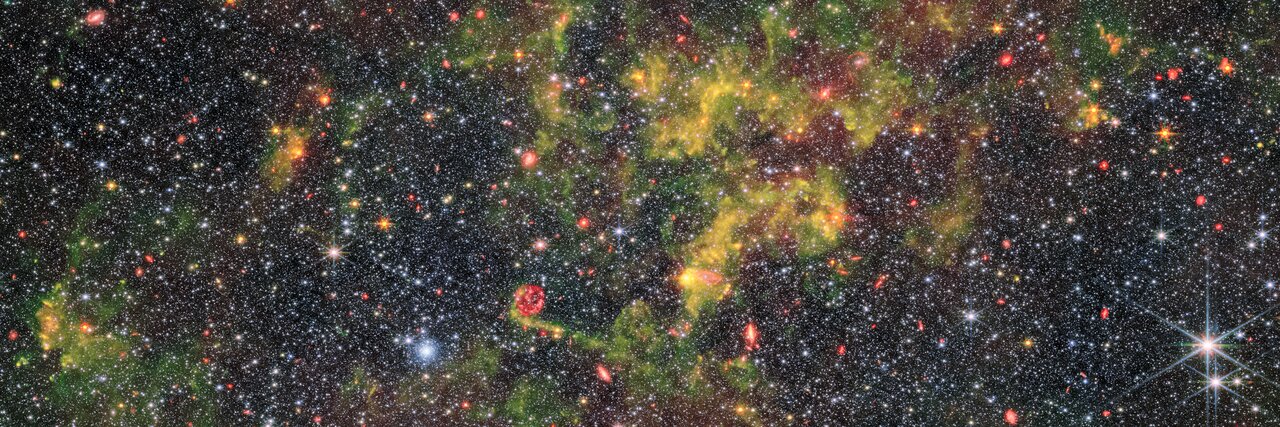James Webb Space Telescope Discovery
Clicking on each image will open the full resolution one. Try it!Clicking on "Raw images" image will yield all the relevant raw images.
The life and times of dust
This image shows the irregular galaxy NGC 6822, which was observed by the Near-InfraRed Camera (NIRCam) and Mid-InfraRed Instrument (MIRI) mounted on the NASA/ESA/CSA James Webb Space Telescope. As their names suggest, NIRCam and MIRI probe different parts of the electromagnetic spectrum. This allows the instruments to observe different components of the same galaxy, with MIRI especially sensitive to its gas-rich regions (the yellow swirls in this image) and NIRCam suitable for observing its densely packed field of stars.
NGC 6822 lies about 1.5 million light-years away, and is the Milky Way’s nearest galactic neighbour that is not one of its satellites. It has a low metallicity, meaning that it contains low proportions of elements that are not hydrogen and helium. Metallicity is an absolutely key concept in astronomy, in part because elements other than hydrogen and helium are largely produced by stars over their lifetimes. Therefore, in the very early Universe (before the first generation of stars had been born, lived and died) everything had very low metallicity. This makes contemporary low-metallicity objects (like NGC 6822) objects of interest for understanding how processes such as the evolution of stars and the life cycle of interstellar dust likely occurred in the early Universe. This was the motivation for these observations of NGC 6822 with Webb: to better understand how stars form and how dust evolves in low-metallicity environments.
The study of NGC 6822 has an interesting history that long predates modern investigations with Webb. It was first discovered by E. E. Barnard, who presented his discovery in a very brief paper in 1884 in The Sidereal Messenger: a short-lived but important American monthly astronomical journal that was published between 1882 and 1891. As with many astronomical objects that appeared diffuse with telescopes of the time, NGC 6822 was miscategorised as an “exceedingly faint nebula”.
Over the next few years, a series of confusions arose around NGC 6822 over its apparent size, brightness, and even what kind of object it was, because astronomers at the time did not properly account for how different the same object might look with different telescopes. Edwin Hubble, namesake of the NASA/ESA Hubble Space telescope, went on to study NGC 6822 in depth and published a far more detailed paper of his own in 1925. This work was exceptionally important for humanity’s evolving understanding of the Universe, because, in Hubble’s own words: “N.G.C. 6822, [was] the first object definitely assigned to a region outside the galactic system”. This paper contributed to solving the debate that was raging amongst astronomers about the extent of the Universe at the time by demonstrating that there were astronomical objects that lay beyond the Milky Way. The study of this galaxy was notably continued by Susan Kayser, who was the first woman to receive a PhD in astronomy from Caltech. Her 1966 thesis remained the most thorough investigation of this galaxy until the 2000s. Now, the study of this key local galaxy is being continued by Webb.
Credit: ESA/Webb, NASA & CSA, M. Meixner
 NGC 6822 (NIRCam + MIRI image)
NGC 6822 (NIRCam + MIRI image)
This image shows the irregular galaxy NGC 6822, as observed by the Mid-InfraRed Instrument (MIRI) mounted on the NASA/ESA/CSA James Webb Space Telescope. MIRI probes the mid-infrared, which in this case makes it perfectly suited to observe the dense regions of gas that suffuse this galaxy.
At mid-infrared wavelengths the emission of light by galactic dust is prominent, obscuring the galaxy’s stars which themselves are faint at these longer wavelengths. Brilliant blue gas indicates light emitted by organic compounds called polycyclic aromatic hydrocarbons, which play a critical role in the formation of stars and planets. Cyan marks cooler patches of dust, while warmer dust is more orange.
Distant galaxies far beyond NGC 6822 are displayed in orange. The few galaxies that are relatively closer, meanwhile, are marked in green by their own light-emitting dust, which MIRI can pick out. Bright red and magenta colours indicate active areas of star formation in the galaxy. With so many stars, supernova explosions are routine, and an amazing example of a supernova remnant is visible in this image: a red ring just below the centre.
 NGC 6822 (MIRI image)
NGC 6822 (MIRI image)
This scaled image shows the irregular galaxy NGC 6822, which was observed by the Near-InfraRed Camera (NIRCam) mounted on the NASA/ESA/CSA James Webb Space Telescope.
Webb’s near-infrared NIRCam image shows the galaxy’s countless stars in incredible detail. Here, the dust and gas that pervade the galaxy are reduced to translucent red wisps, laying the stars bare for astronomical study. The power of Webb’s ice-cold infrared instruments and the incredible resolution of its primary mirror is necessary to examine stars hidden in dusty environments, and the results as shown here are spectacular.
The brightest stars appear in pale blue and cyan colours in this image, colours which are assigned to the shortest wavelengths of light that NIRCam can detect: red and near infrared. The amount of light emitted by any star decreases at longer and longer wavelengths, towards the mid-infrared, so the stars that are more faint to NIRCam also appear more warmly coloured here. A bright blue orb to the lower left of the gas is particularly prominent: this is a globular cluster, packed with stars.
 NGC 6822 (NIRCam image)
NGC 6822 (NIRCam image)
 Difference between MIRI and NIRCam
Difference between MIRI and NIRCam
 Raw images
Raw images